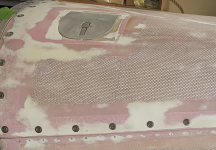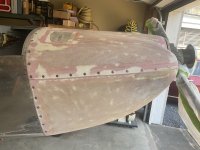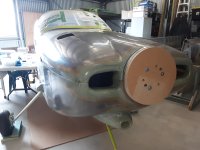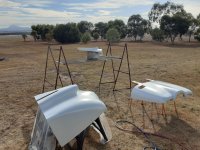Not only the battle but the war was won with my pink Pepto Bismol cowl from HE.. and as my solemn word, I will never build a glass airplane. For those that have one of these pink atrocities, I thought I would share a few things I learned in hopes it will be of help in the same way VAF has helped me on other projects.
Since this cowl has a honeycomb interior, it has horrible pinholes and depressions I referred to as craters in the honeycomb section. I used UV Smooth Prime on other fiberglass parts and it did a good job filling pinholes, I thought it would work fine on the cowl. It did on the periphery where there was no honeycomb. After sanding the primer off, you could still feel the depressions in the honeycomb section with your fingers. The pin holes were filled, but they were still depressions.
The remedy was to follow Dan Horton‘s advice. Using a foam roller, I rolled three coats of neat epoxy and sanded until the orange peel was gone. The surface is now perfectly smooth and free of any depressions/craters. Looking back, I should have eliminated the Smooth Prime and only have done the epoxy step which would have saved a lot of time.
IMHO sanded neat epoxy isn’t the easiest or the fastest way to tackle pinholes, however it produces the best results. In this particular case, I could’ve eliminated the primer and cut my time in half.
Since this cowl has a honeycomb interior, it has horrible pinholes and depressions I referred to as craters in the honeycomb section. I used UV Smooth Prime on other fiberglass parts and it did a good job filling pinholes, I thought it would work fine on the cowl. It did on the periphery where there was no honeycomb. After sanding the primer off, you could still feel the depressions in the honeycomb section with your fingers. The pin holes were filled, but they were still depressions.
The remedy was to follow Dan Horton‘s advice. Using a foam roller, I rolled three coats of neat epoxy and sanded until the orange peel was gone. The surface is now perfectly smooth and free of any depressions/craters. Looking back, I should have eliminated the Smooth Prime and only have done the epoxy step which would have saved a lot of time.
IMHO sanded neat epoxy isn’t the easiest or the fastest way to tackle pinholes, however it produces the best results. In this particular case, I could’ve eliminated the primer and cut my time in half.









